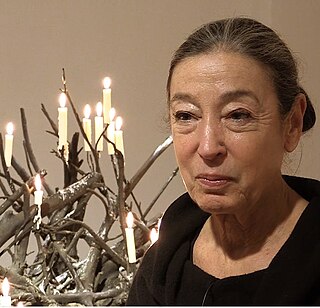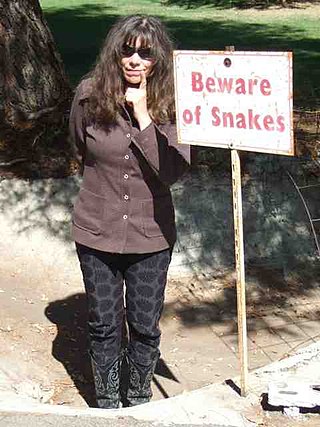Regis Brodie is a tenured Professor of Art at the Department of Art and Art History at Skidmore College in Saratoga Springs, NY and a potter. Since 1972, he has been serving as the Director of the Summer Six Art Program at Skidmore College. He also wrote a book called The Energy Efficient Potter which was published by Watson-Guptill Publications in 1982. He started the Brodie Company in 1999 in the interest of developing tools which would aid the potter at the potter's wheel.

The John Michael Kohler Arts Center is an independent, not-for-profit contemporary art museum and performing arts complex located in Sheboygan, Wisconsin, United States. The center preserves and exhibits artist-built environments and contemporary art. In 2021, the center opened the Art Preserve, a satellite museum space dedicated to art environments.
Adrian Saxe is an American ceramic artist who was born in Glendale, California in 1943. He lives and works in Los Angeles, California.

Arnold Zimmerman (1954-2021), also known as Arnie Zimmerman, was an American sculptor and ceramic artist. His work ranged from monumental to miniature, and abstract to figurative, encompassing totemic vessel forms, tabletop sculpture and figures, murals, and room-size installations. He was part of a multi-decade, 20th-century shift in American ceramics during which artists challenged clay's identification with function and craft, engaging fine-art domains such as emotional expression, social commentary, figuration and narrative. Zimmerman first gained recognition in the 1980s for deeply carved, architectonic sculptures characterized by rough physicality, rhythmic surfaces, gestural presence and Italian Romanesque influences. In the mid-1990s, he shifted to figurative work that critic Donald Kuspit wrote, examined the interaction of finite man and infinite matter, artist and creative work: "There is a sense of futility and folly as well as seemingly senseless idealism and innocence built into Zimmerman's parables of the all-too-human."

Beth Cavener, also known as Beth Cavener Stichter, is an American artist based out of Montana. A classically trained sculptor, her process involves building complex metal armatures to support massive amounts of clay. Cavener is best known for her fantastical animal figures, which embody the complexity of human emotion and behavior.

Michele Oka Doner is an American artist and author who works in a variety of media including sculpture, prints, drawings, functional objects and video. She has also worked in costume and set design and has created over 40 public and private permanent art installations, including “A Walk On The Beach,” a one and a quarter mile long bronze and terrazzo concourse at Miami International Airport.
Sueharu Fukami is a Japanese ceramic artist and sculptor known for his work in pale-blue qinbai porcelain. Fukami's abstracted, sculptural ceramic works depart from the traditional Japanese artisan traditions of his upbringing and instead explore natural phenomena and universal senses like "infinite space" through sharp silhouettes, sweeping curves, architecturally-inspired arches, and delicately-colored glaze. His minimalist approach to porcelains has contributed to defining and expanding the meaning, importance, and popularity of contemporary Japanese ceramics beyond craft art circles, most notably to fine art collectors and museums globally.

Mary Jo Bole, US, is a sculptor, printmaker, and artist-bookmaker who lives and works in Columbus. Bole has exhibited her works in the United States and Europe. She was a professor of art at Ohio State University.

Ann Agee is an American visual artist whose practice centers on ceramic figurines, objects and installations, hand-painted wallpaper drawings, and sprawling exhibitions that merge installation art, domestic environment and showroom. Her art celebrates everyday objects and experiences, decorative and utilitarian arts, and the dignity of work and craftsmanship, engaging issues involving gender, labor and fine art with a subversive, feminist stance. Agee's work fits within a multi-decade shift in American art in which ceramics and considerations of craft and domestic life rose from relegation to second-class status to recognition as "serious" art. She first received critical attention in the influential and divisive "Bad Girls" exhibition, curated by Marcia Tucker at the New Museum in 1994, where she installed a functional, handmade ceramic bathroom, rendered in the classic blue-and-white style of Delftware. Art in America critic Lilly Wei describes Agee's later work as "the mischievous, wonderfully misbegotten offspring of sculpture, painting, objet d'art, and kitschy souvenir."
Nicole Cherubini is an American visual artist and sculptor. She lives and works in New York.
Jack Doherty is a Northern Irish studio potter and author. He is perhaps best known for his vessels made of soda-fired porcelain. He has been featured in a number of books, and his work has been exhibited widely in both Europe and North America. Articles of his have appeared in various pottery journals and he has been Chair of the Craft Potters Association.

Arlene Shechet is an American sculptor known for her inventive, gravity-defying arrangements and experimental use of diverse materials. Critics describe her work as both technical and intuitive, hybrid and polymorphous, freely mixing surfaces, finishes, styles and references to create visual paradoxes. Her abstract-figurative forms often function as metaphors for bodily experience and the human condition, touching upon imperfection and uncertainty with humor and pathos. New York Times critic Holland Cotter wrote that her career "has encompassed both more or less traditional ceramic pots and wildly experimental abstract forms: amoebalike, intestinal, spiky, sexual, historically referential and often displayed on fantastically inventive pedestals … this is some of the most imaginative American sculpture of the past 20 years."
Myra Mimlitsch-Gray is an American metalsmith, artist, critic, and educator living and working in Stone Ridge, New York. Mimlitsch-Gray's work has been shown nationally at such venues as the John Michael Kohler Arts Center, Museum of the City of New York, Metropolitan Museum of Art, Cooper-Hewitt Smithsonian Design Museum, and Museum of Arts and Design. Her work has shown internationally at such venues as the Middlesbrough Institute of Modern Art, Stadtisches Museum Gottingen, and the Victoria and Albert Museum, and is held in public and private collections in the U.S, Europe, and Asia.
Clare Twomey is a London-based visual artist and researcher, working in performance, serial production, and site-specific installation.
Jack Earl is an American ceramic artist and former teacher, known for drawing inspiration from his home state of Ohio to create rural pieces “with meticulous craftsmanship and astute details… to where you could smell the air, hear the silence and swat the flies.” Although his works hint at highly personal, intellectual, and narrative themes in an almost unsettling manner, Earl is “a self-described anti-intellectual who shuns the art world." He is known particularly for using his trademark format, the dos-a-dos : “This art form is like a book with two stories… the two seemingly incongruent images prompt the viewer to fill in the conceptual gap through poetic speculation.” His work often involves dogs or the character “Bill”, who is said to be a combination of Earl’s father-in-law, himself, and others. The titles to his pieces are typically lengthy, stream-of-consciousness narratives that suggest the folk or rural lifestyle. These are intended to add another dimension to the artwork. His work has received a notable response over his decades-long career, especially since he is regarded as “a master at reminding us that within the events we take for granted are moments of never-ending mystery and wonder.” Earl continues to live in Lakeview, Ohio with his wife, Fairlie.
Richard Shaw is an American ceramicist and professor known for his trompe-l'œil style. A term often associated with paintings, referring to the illusion that a two-dimensional surface is three-dimensional. In Shaw's work, it refers to his replication of everyday objects in porcelain. He then glazes these components and groups them in unexpected and even jarring combinations. Interested in how objects can reflect a person or identity, Shaw poses questions regarding the relationship between appearances and reality.
Melissa Stern is an American artist and journalist. Her drawing and sculpture have been exhibited in museums, galleries, private and corporate collections throughout the world. Her art reviews and cultural commentary have been featured in Hyperallergic, the Brooklyn-based digital arts publication. She serves as Art Editor for Posit, a journal of literature and art.

Nancy Selvin is an American sculptor, recognized for ceramic works and tableaux that explore the vessel form and balance an interplay of materials, minimal forms, and expressive processes. She emerged in the late 1960s among a "second generation" of Bay Area ceramic artists who followed the California Clay Movement and continued to challenge ceramic traditions involving expression, form and function, and an art-world that placed the medium outside its established hierarchy. Her work has been exhibited at the Los Angeles County Museum of Art (LACMA), Denver Art Museum, Daum Museum of Contemporary Art and Kohler Arts Center, and belongs to the public art collections of LACMA, the Smithsonian Institution, Oakland Museum of California, and Crocker Art Museum, among others. Critic David Roth has written, "Selvin's position in the top rank of ceramic artists has come through a process of rigorous self-examination … what differentiates [her] is that she eschews realism and functionality, indicating a level of intellectual engagement not always found among ceramicists." Writer and curator Jo Lauria described Selvin's tableaux as "elegiac and stylistically unified" works that serve as "forceful essays on the relationship between realism and abstraction, object and subject, decoration and use." Selvin lives and works in the Berkeley, California area.
Michael Sherrill is an American ceramist and sculptor. Primarily self-taught, Sherrill's early work in the 1970s and 1980s focused on creating functional pieces in clay before turning to sculptural artwork in porcelain and metal in the 1990s. Sherrill lives and works in Bat Cave, North Carolina.
Anders Herwald Ruhwald is a Danish-American sculptor. He works primarily in clay, a medium he has been drawn to since he was 15. Ruhwald's work blends references from functional objects to classical sculpture and can take the form of singular objects as well as immersive installations













